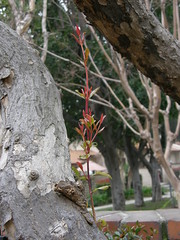This has been a really frustrating Fall for me. After making my decision to become a math teacher at a time when everyone said that jobs would fall into my lap, and then discovering that that is definitely
not the case, I have found classes at Claremont Graduate University both inspiring and depressing - the last particularly when the speaker refers to "your students," of course. But at this point, there are still about 10 of us in secondary math, who do not yet have an Internship position.
So I have
bought most of the new books available from the
National Council of Teachers of Mathematics and used copies of a variety of math teaching materials, in particular
Core-Plus Mathematics Contemporary Mathematics in Context from Glencoe. I've beeing reading about
Sensemaking and learning through
Discovery and
Problem Solving, which really "make sense" to me as a way to get students interested in what they are learning.
Core-Plus, which has units in Algebra, Geometry, Statistics, etc. each year, instead of separate years, looks like a fantastic way to teach math, except that it would be really hard to implement, since any student who switches schools would be lost wherever else they went. That is probably why there are so many used materials on Amazon.
I've also enjoyed the materials I discovered at the website for
Geometer's Sketch Pad, which is a fun way to do geometry (and I understand other math subjects.) I found that they have great online resources for their
Algebra and Geometry books, including some in Spanish. I also discovered the Prentice Hall Multilingual Handbooks - all available for almost nothing at Amazon. They included glossaries, etc. in a variety of languages, not just Spanish. But evidently Spanish is the only language that districts want to invest in. I just found a
letter from a parent complaining about the creative math texts (dating back to 1996.)
I have also been
observing classrooms - I'm required to observe 25 hours, including special ed and bilingual classrooms, and I've observed more than that now. What I see is teachers doing direct instruction and students doing work sheets. In some classes, text books are stacked somewhere in the classroom, or the students have a copy at home, but they are not being used. The ones I've looked at with my inexperienced eyes seems really exciting, if you want to teach by discovery and problem solving. But kids are learning how to solve problems on work sheets - and on standardized tests. I understand that there are pacing guides at the schools, that decide, for example, that next week all Algebra I teachers will be teaching solving two equations with graphing or substitution. No need to use a text book for that. No need to discover anything, when you can just do problems. Teachers tell me that the enormous textbooks just have too much material in them - and of course they're too heavy to carry around! So all the thought that went into making them (so they'd fit most any state's standards!) is just gathering dust.
To make myself more "hireable," I just did a quick (one month) review of physics and took the
teaching qualification exam, CSET Physics III last Saturday. Now I have to decide whether to take Physics IV, to qualify as a physics teacher, or Science I and II (including biology, chemistry, earth and planetary science as well as physics) to be able to be a General Science teacher. Or maybe I'll just use the physics I've reviewed to provide more "authentic" problenms for my students.
Finally, I've been
writing a few lesson plans, which are assignments for this semester at Claremont Graduate University - writing a total of 3 lessons that will benefit English Language Learners (ELLs) or students with other learning issues, like dyslexia or autism. I've written lessons that involve discovery and sense-making, since I'm not in a classroom trying to keep up with the pacing guide to make sure the kids do well on standardized tests. I'm afraid that my idealism will hit the dust when I finally do get into my own classroom.


